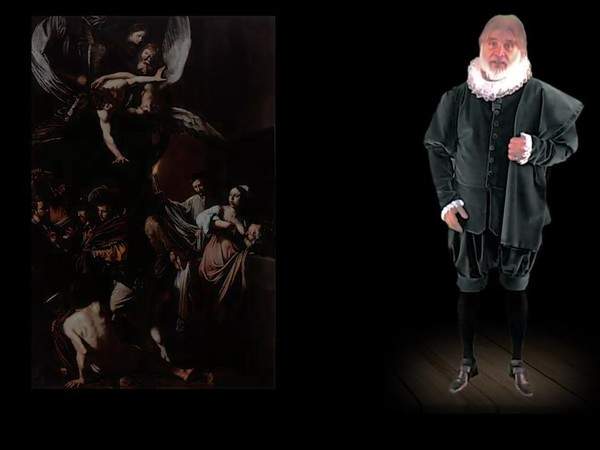Pio Monte della Misericordia presents the new project Caravaggio, a new light, which will be available to the public from July 13 to Dec. 31. The initiative, produced in collaboration with AR Tour, tells the story of the Pio Monte Chapel in a new way: a journey between innovative technologies and new narrative forms, to relive a story more than four centuries old.
A tour of the Chapel, produced thanks to images, films and virtual reconstructions: new multimedia content that can be enjoyed through 3D glasses that use augmented reality technology for a real leap back in time.
“Adapting to the times and being up-to-date is an important goal for Pio Monte della Misericordia,” explains Alessandro Pasca di Magliano, Superintendent of Pio Monte della Misericordia. “A centuries-old institution that does not give up using the most modern technologies, useful so that the enjoyment of works of art is as comprehensive as possible. Thanks to the new 3D glasses, visitors will be able to see with their own eyes how the Pio Monte came into being, what beauties it holds and have all the additional information they desire.”
“The enhancement project promoted by Pio Monte, based on augmented reality technology, is of great interest,” says Ludovico Solima, professor of Cultural Enterprise Management atVanvitelli University, "because it it testifies to the Authority’s aptitude for experimenting with particularly innovative solutions aimed at improving its capacity for dialogue with its audiences, consequently increasing its attractiveness to current and potential visitors. The adoption of new forms of storytelling, made possible by technologies such as 3D glasses, makes it possible to propose a highly engaging narrative, through which to tell not only about Caravaggio’s masterpiece, but also about the other works in the Chapel and the Quadreria and, more generally, about the aims of the Institution, reminding users that art, in this case, is at the service of the common good."
The choice of Pio Monte was directed in the creation of a subject and narrative text aimed at recreating the atmosphere of the seventeenth century and explaining the birth of the Institution, through the drafting of a screenplay written expressly by Maurizio Burale, head of cultural projects at Pio Monte della Misericordia. A historical reconstruction, careful and detailed, for all intents and purposes.
Wearing 3D glasses, the visitor is immediately immersed in the era and accompanied on a tour of the Pio Monte Chapel by an exceptional protagonist: Giovan Battista Manso, one of the first governors of Pio Monte, played by actor Peppe Celentano. Giovan Battista Manso was among the most prominent men of the nobility of the Spanish Viceroyalty. He held important military and political posts, was also a man of letters, patron of the arts, and founder of theAccademia degli Oziosi. In 1608 he founded an important charitable institution still active today: the Real Monte Manso di Scala. He participated in the founding of the Pio Monte della Misericordia and was in charge of overseeing the construction of the headquarters on Via dei Tribunali. He is the one who serves as the cicerone and narrates the history of the Pio Monte and its foundation, painting an exact picture of the historical context of the time and illustrating the cardinal principles that have animated its mission to help the needy from its earliest days.
Giovan Battista Manso is also joined by other characters such as the Archivario and Caravaggio himself, starring in a small cameo, virtually inserted and played by actors Gennaro Monti and Massimo Masiello, respectively. Manso acts as narrator, immersing the visitor in the painting ofThe Seven Works of Mercy, meticulously explaining the reasons why Caravaggio comes to Naples, while the characters in the painting come to life in sequence. It is an opportunity to tell the visitor not only who they are, but also what work of Mercy they represent. The finale closes with Mansoa ’s invitation to visit the entire complex, which houses a wonderful Quadreria on the main floor.
“The technology that characterizes our glasses, namely Augmented Reality,” says Luigi Percuoco, CEO of AR Tour, “allows us to never lose contact with the context that surrounds us, and therefore, the Chapel and all the historical and artistic beauties that characterize it will always be in the foreground. Additional elements, such as 3D images, holograms and various information, will appear on the lenses, which are totally transparent, supporting and enriching the fruition process. All this will allow us to appreciate one of the most important masterpieces of the Neapolitan 600s in an innovative way.”
Superimposed on the painting of The Seven Works of Mercy is a high-resolution image by photographer Luciano Pedicini. Not only that, the characters in the painting, through rendering, appear in relief outside the work, restoring an embellished and evocative reality.
The narrative is enriched, moreover, by numerous works by artists such as Gaspar van Wittel, Antonio Joli, Jusepe de Ribera, Andy Wharol for views of Vesuvius, Micco Spadaro for scenes of the people, Luca Giordano for some details reconstructing the period of the plague in Naples, and Vincenzo Migliaro for the pictorial rendering of the Neapolitan city.
For all information you can visit the official website of Pio Monte della Misericordia.
 |
| Naples: Caravaggio in augmented reality at Pio Monte della Misericordia |
Warning: the translation into English of the original Italian article was created using automatic tools. We undertake to review all articles, but we do not guarantee the total absence of inaccuracies in the translation due to the program. You can find the original by clicking on the ITA button. If you find any mistake,please contact us.